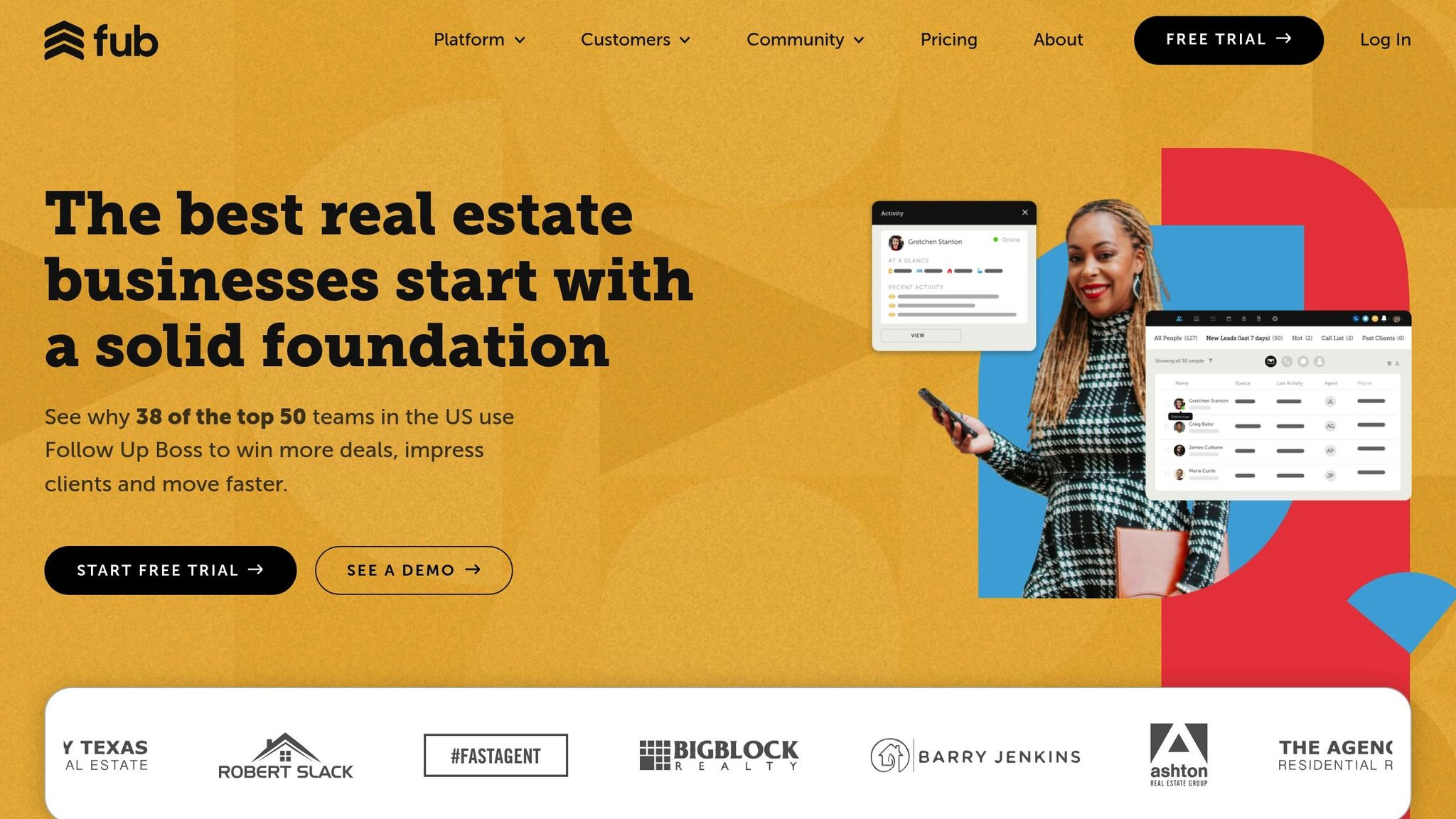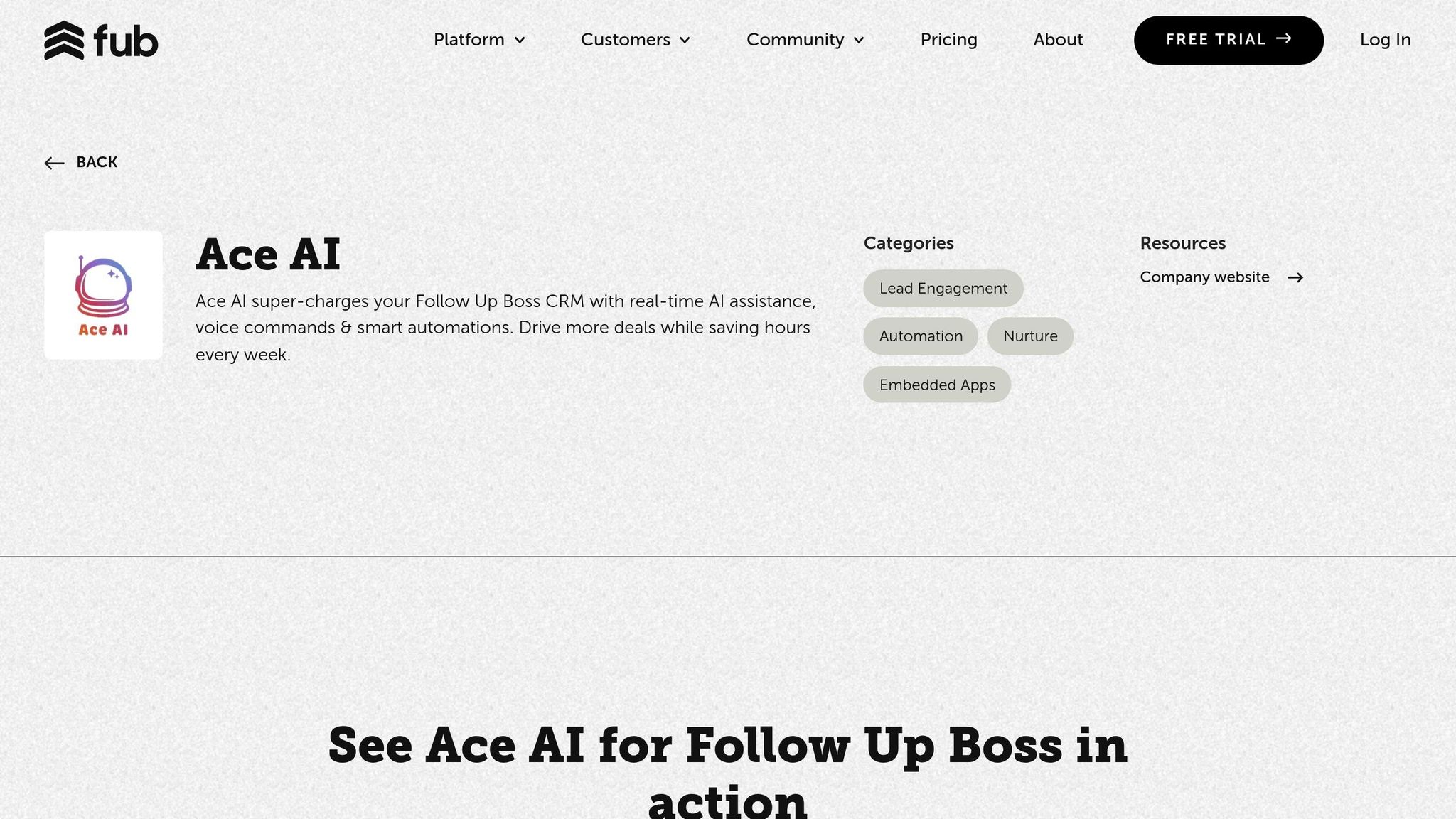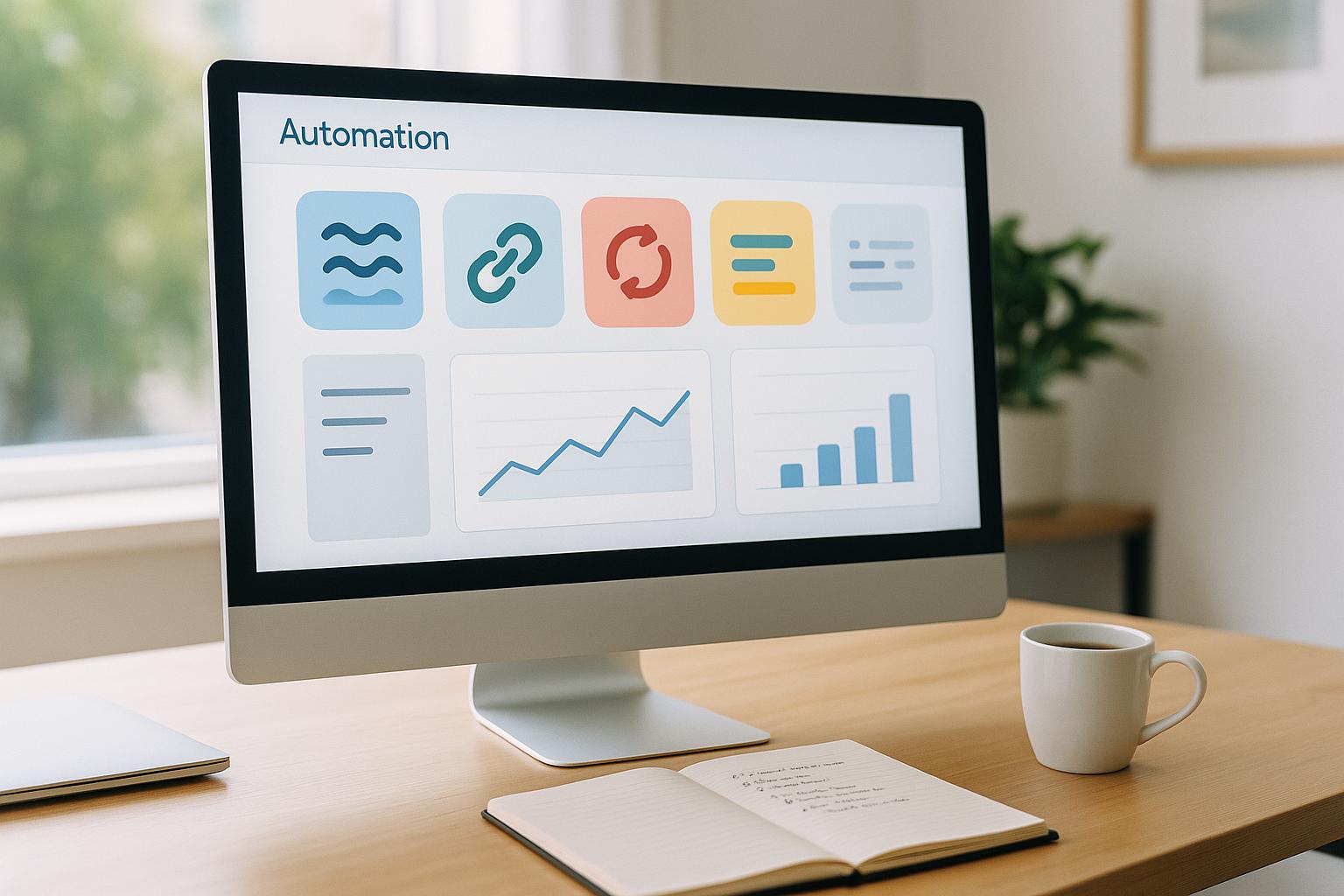Custom Webhooks in Follow Up Boss: Setup Guide
Custom webhooks in Follow Up Boss enable real-time data sharing between your CRM and other systems, automating tasks and improving workflows. Here’s what you need to know:
- What They Do: Send JSON data to a specified URL when CRM events occur (e.g., new leads, task updates).
- Key Benefits:
- Automate lead assignment and notifications.
- Streamline workflows and reduce manual tasks.
- Boost response times and follow-up efficiency.
- Setup Essentials:
- Account owner access and API key.
- Secure HTTPS endpoint for receiving data.
- Proper handling of JSON payloads and security protocols.
- Supported Events: Leads, communication (emails, texts), tasks, appointments, and deals.
Quick Start:
- Create a secure webhook endpoint (e.g., using Express.js).
- Register the endpoint in Follow Up Boss with required parameters.
- Test and monitor performance to ensure reliability.
With proper setup, webhooks can enhance your CRM’s functionality, ensuring smooth operations and better lead management.
How to Connect Webhooks to Follow Up Boss - Easy Integration

Required Setup Components
To set up webhooks in Follow Up Boss, make sure you have everything in place before diving into the configuration process.
System Access Requirements
Only the account owner has the authority to manage webhooks, as outlined in the documentation. This includes creating, editing, and deleting webhook integrations.
You'll also need to generate an API key from an admin account to handle authentication.
Technical Requirements
For webhooks to work smoothly, you’ll need:
- A secure HTTPS endpoint to receive webhook data.
- The ability to handle HTTP requests and responses effectively.
- Infrastructure (server or application) capable of processing JSON payloads.
- Familiarity with data encryption and security protocols.
Tools like Request Bin can be handy for testing and verifying the delivery of JSON payloads.
Supported Event Types
Follow Up Boss supports a wide range of CRM events through webhooks. Below is a breakdown of the main event categories and their triggers:
| Event Category | Common Triggers |
|---|---|
| Lead Management | New lead creation, Status updates, Assignment changes |
| Communication | Emails, Text messages, Calls, Notes |
| Task Tracking | Task creation, Updates, Completion |
| Appointments | Scheduling, Modifications, Cancellations |
| Deals | Stage changes, Updates, Closings |
Action plans are triggered only for leads under the following categories:
- Registration
- Seller Inquiry
- Property Inquiry
- General Inquiry
- Visited Open House
This setup ensures that your automated workflows align with standard practices in real estate while keeping the system running efficiently.
Once these components are ready, you can move on to configuring your endpoint in the next section.
Setup Instructions
Setting up custom webhooks in Follow Up Boss requires careful attention to both technical setup and security measures.
Creating Your Endpoint
To start, you'll need to configure a webhook endpoint capable of handling HTTP POST requests.
1. Create a Secure HTTPS Endpoint
Establish a dependable endpoint that listens for incoming webhook events. Here's an example using Express.js:
const express = require('express');
const app = express();
app.post('/webhook', express.json(), (req, res) => {
console.log('Webhook received:', req.body);
res.sendStatus(200);
});
app.listen(3000, () => console.log('Webhook server running on port 3000'));
2. Implement Response Handling
Ensure your endpoint responds promptly - within 10 seconds - with a 2XX status code. Log any errors to troubleshoot issues effectively.
Adding Webhooks to Follow Up Boss
Once your endpoint is ready, it’s time to register it with Follow Up Boss. Follow these steps:
| Step | Action | Required Parameters |
|---|---|---|
| 1 | Generate API Key | Account owner access required |
| 2 | Create POST Request | Endpoint URL, Event type, X-System header |
| 3 | Configure Security | FUB-Signature verification |
| 4 | Set Response Codes | 2XX for success, 406/410 for deletion |
After registration, confirm the webhook is functioning as expected by running tests.
Endpoint Testing
With the webhook registered, you’ll need to test its functionality and ensure it performs as intended.
1. Initial Setup Testing
During development, tools like Request Bin can capture and inspect webhook payloads. This helps verify that your endpoint is receiving and processing data correctly.
2. Production Verification
Test your endpoint in a production-like environment. Here’s an example using Axios in Express.js:
const axios = require('axios');
function testWebhook() {
axios.post('https://your-app.com/webhook', {
event_type: 'lead.created',
data: { name: 'Test Lead', email: '[email protected]' }
})
.then(() => console.log('Test webhook sent successfully'))
.catch(error => console.error('Test failed:', error));
}
testWebhook();
3. Performance Monitoring
Keep an eye on your webhook’s performance over time. Key metrics to monitor include:
- Response times (should remain under 10 seconds)
- Successful delivery rates
- Retry attempts
- Security verification failures
"When registering a webhook, you should use a unique identifier that maps a user to your system. Do not use API keys as part of a URL request."
sbb-itb-b3b90a6
Security and Performance Tips
Ensuring secure and efficient webhook operations in Follow Up Boss requires a combination of strong security practices and performance optimization.
Payload Security
Protecting webhook payloads begins with verifying their authenticity. HMAC signatures are a reliable method to confirm that requests are genuine and unaltered.
-
Generate a Secret Token
Start by creating a unique secret token for your webhook endpoint. Keep this token in a secure location, and avoid exposing it in your codebase or version control systems. -
Implement Signature Verification
Use HMAC signatures to validate the integrity of incoming requests. Here's an example in JavaScript:const crypto = require('crypto'); function verifySignature(payload, signature, secret) { const computedSignature = crypto .createHmac('sha256', secret) .update(payload) .digest('hex'); return crypto.timingSafeEqual( Buffer.from(signature), Buffer.from(computedSignature) ); }
With signature verification in place, you can ensure that webhook requests are authentic and tamper-free.
Data Protection
Once you've confirmed the authenticity of a payload, the next step is safeguarding the data during transit and storage. Here are some practical steps:
| Security Measure | Implementation | Purpose |
|---|---|---|
| HTTPS Encryption | Use SSL/TLS protocols | Protect data during transit |
| Payload Validation | Apply input sanitization | Prevent injection attacks |
| Request Timestamps | Set expiration windows | Block replay attacks |
| Activity Logging | Log all webhook events | Enable security monitoring |
These measures help maintain data integrity and protect against potential threats.
Traffic Management
To ensure consistent performance, especially during high-traffic events, it's crucial to manage webhook traffic effectively. Here’s how you can handle it:
-
Rate Limiting
Implement rate limiting to prevent overload. For instance, you can restrict each IP to 100 requests within a 15-minute window using the following code:const rateLimit = { windowMs: 15 * 60 * 1000, // 15 minutes max: 100, // Limit each IP to 100 requests per window message: 'Too many requests, please try again later' }; -
Monitor Key Metrics
Keep an eye on critical performance indicators like:- Response times (aim for under 10 seconds)
- Delivery success rates
- Queue lengths
- Error frequencies
-
Retry Logic
Use progressive retries for failed requests: attempt again after 5 minutes, then 15 minutes, and finally 60 minutes.
For best results, acknowledge webhook receipt immediately by returning a 200 OK response. Then, process the payload asynchronously through a queue system to maintain optimal performance and avoid bottlenecks.
Ace AI Integration Features

Ace AI takes CRM automation to the next level with advanced integration tools, building on secure webhook setups and optimized performance. By leveraging Follow Up Boss webhooks, Ace AI simplifies lead management and helps teams work more efficiently.
Automated Workflows
Ace AI transforms webhook triggers into actionable tasks within Follow Up Boss, cutting down on manual work and streamlining processes. On average, it handles around 560 CRM tasks per team each week. Here's a breakdown of how it works:
| Webhook Event | Ace AI Action | Business Impact |
|---|---|---|
| peopleCreated | Launches a tailored welcome sequence | Speeds up lead response times |
| notesCreated | Updates contact records and sets follow-ups | Keeps lead nurturing consistent |
| callsCreated | Logs call details and schedules next steps | Sustains engagement with leads |
| textMessagesCreated | Suggests AI-driven responses | Improves communication efficiency |
Voice and Chat Controls
With Ace AI’s voice and chat interface, agents can manage CRM updates without lifting a finger. This hands-free solution makes everyday tasks easier, allowing agents to devote more time to building meaningful client relationships instead of getting bogged down by data entry.
Lead Response System
Ace AI uses webhook data to power smart follow-up sequences. One company saw its speed-to-lead double and enjoyed a 27% jump in conversions. The system analyzes lead behavior, creates tailored templates, schedules follow-ups at the right time, and tracks engagement. All of this operates under enterprise-grade compliance, ensuring data security and reliability.
Summary
Set up and execute real-time synchronization using Follow Up Boss webhooks to streamline automated workflows for lead management and team coordination.
To ensure successful webhook implementation, prioritize these key components:
| Component | Best Practice | Impact |
|---|---|---|
| Security | Use HTTPS endpoints with signature verification | Protects data integrity and verifies authenticity |
| Response Time | Process requests within a 10-second window | Keeps the system responsive and reliable |
| Error Handling | Implement an 8-hour retry mechanism | Minimizes data loss during system outages |
| Resource Management | Separate event reception from processing | Enhances overall system performance |
These practices ensure that webhooks remain dependable and adaptable. As Team Lead Tarasa Hurley puts it:
"For us it's not about any one integration. It's that the extensive open API allows us to integrate whatever we please".
Ace AI applies these principles to power seamless, automated CRM workflows. The results speak for themselves - one real estate team using Ace AI saw their speed-to-lead metrics double and experienced a 27% jump in conversions within just one month. On average, automated workflows manage around 560 CRM tasks weekly, freeing up valuable time for direct client interactions.
FAQs
How can I keep my data secure when using custom webhooks in Follow Up Boss?
To keep your data secure when using custom webhooks in Follow Up Boss, consider these essential practices:
- Always use HTTPS: Encrypt data during transmission to protect it from unauthorized access or interception.
- Verify incoming requests: Use a unique identifier or secret key to ensure requests come from a trusted source.
- Block replay attacks: Add timestamps or unique tokens (nonces) to your webhook requests to prevent duplicate or malicious submissions.
Taking these steps helps protect sensitive information and ensures secure communication through your webhooks.
What should I do if my webhook endpoint isn’t responding within the 10-second limit?
If your webhook endpoint isn’t responding within the required 10-second window, the first step is to ensure your server is operating efficiently. Check for any signs of high CPU or memory usage that could be slowing things down. Also, verify that the endpoint URL is accurate, accessible, and correctly set up to return a 200 status code, which signals successful receipt of the webhook.
Still having trouble? Take a closer look at your server logs to identify potential errors or performance bottlenecks causing the delays. You might also consider adding retry logic or exploring whether adjusting your server's timeout settings could help. Keeping your server responsive and well-tuned will go a long way in addressing this issue.
How can I customize which events in Follow Up Boss trigger a webhook, and where do I adjust these settings?
You have full control over which events in Follow Up Boss activate a webhook by selecting specific actions - like new leads or updates - right in the webhook settings. All of this can be managed directly from your Follow Up Boss dashboard.
To make changes, head to the webhook configuration section. There, you’ll see a list of CRM events to choose from. Just pick the actions you want to trigger a webhook, and your preferences will be saved automatically. This way, your webhooks align perfectly with your workflow, keeping you updated on what matters most.
